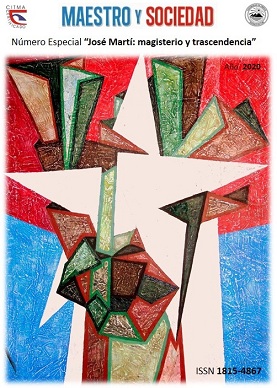Chromotherapy in special initial training: an approach to Martí's thought
Array
Keywords:
language, disorder, teaching, color therapyAbstract
This article aims to summarize the use of color therapy as a technique for the development of language in early childhood education children «Theoretical-didactic conception applicable to the process of training children with language disorders in special education and initial education based on the use of the work of José Martí ». A system of theoretical, analytical and descriptive methods was applied, which complemented each other to obtain, process and present the necessary information. A diagnosis was made taking as a case study the population of children from the “Sonrisas del Mundo” children's circle to show the rate of children with language disorders based on three prevalent opinions. Statistical results showed that the study succeeds in establishing the guidelines for the use of chromotherapy in the development of language from the conception of Marti's thought.
References
2. Diario Formación. (2017). Blog de Formación sin Barreras: "Por una formación accesible, de calidad y con valor curricular". Recuperado de https://diarioformacion.wordpress.com/2017/02/06/la-influencia-de-los-colores-en-el-aprendizaje/
3. Escribano, E. (2016). El proyecto cultural liberador de José Martí para su tiempo y para el siglo XXI. Hallazgos, 13(25), pp. 65-67.
4. Esteban, E. (2019). Cómo influyen los colores en la conducta y emociones de los niños. Recuperado de https://www.guiainfantil.com/blog/educacion/conducta/como-influyen-los-colores-en-la-conducta-y-emociones-de-los-ninos/
5. Fernández, J. M. (2008). Educación Especial. Una aproximación a la investigación en el contexto español. RMIE, 13(38), pp. 945-968.
6. Gómez, J. R. (2018). La ciencia en José Martí. Medisur, 15(5), pp. 599-609.
7. González, E. (s.f.). Evolución de la Educación Especial: Del modelo de déficit al modelo de la Escuela Inclusiva. Granada: (s.e.).
8. Juárez, J. M, Comboni, S. & Garnique, F. (2010). De la Educación Especial a la Educación Inclusiva. Nueva Época, (62), pp.42-52.
9. Leyva, M. (2014). Una nueva mirada a la Educación Especial en Cuba a partir del concepto de discapacidad según la CIF. Recuperado de www.pdffactory.com
10. Marrero, M. (2013). El uso terapéutico de la cromoterapia como método preparatorio en Terapia Ocupacional. CONEXIO, 2(2), pp.17-19.
11. Mateos, G. (2008). Educación especial. Revista Intercontinental de Psicología y Educación, 10(1), pp. 5-12.
12. Mined. (1993-2012). Acerca de la labor reducativa. La Habana: Editorial Pueblo y Educación.
13. OEI. (2010). Sistemas Educativos Nacionales. La Habana: Editorial Pueblo y Educación.
14. Parrilla, A. (1992). La integración escolar como experiencia institucional. Sevilla: GID.
15. Stainback, S. y Stainback, W. (1999). Aulas inclusivas. Madrid: Narcea.
16. Torres, J. A. (2010). Identification of key factors in the educational support to pupils with educational special needs: Teacher support in inclusive education. Review Palacky University Olomouc, pp. 19-56.
17. Torres, J. A. (2011). La identidad científica de la educación especial: marcando el sendero de la inclusión educativa. Rev. Int. Investig. Cienc. Soc. 7(1), pp. 137-162.
Published
How to Cite
Issue
Section
License
This journal provides immediate open access to its content, based on the principle that offering the public free access to research helps a greater global exchange of knowledge. Each author is responsible for the content of each of their articles.



























 Universidad de Oriente
Universidad de Oriente 